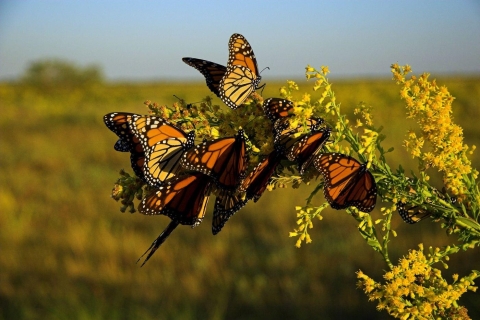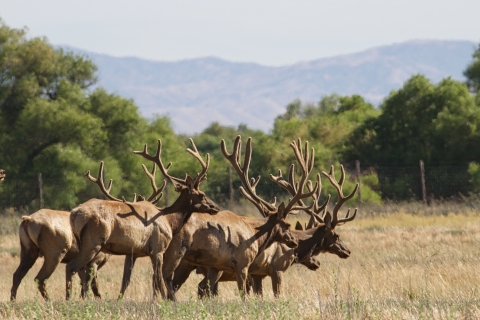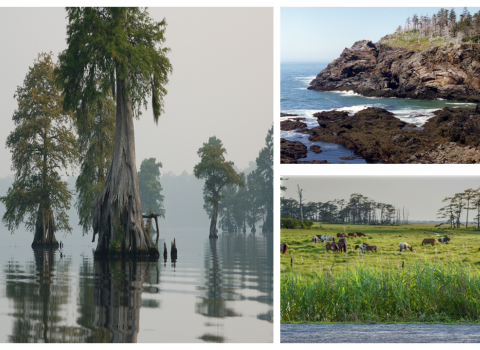Fall is a season of restlessness on national wildlife refuges. All that change and motion means there is lots to capture visitors' attention. As daylight shrinks and the mercury drops, great flocks of ducks, geese and shorebirds start their migrations south and west. Monarch butterflies head for wintering sites in Mexico. Bull elk spar and compete for mates. Color and drama are everywhere.
Monarch Butterflies
Every fall, monarchs fly thousands of miles south to overwinter in Mexico. Along the way, they rest and feed on nectar-bearing plants. If you time your visit right, you might see clusters of the bright orange and black insects blanket trees and shrubs. Each fall, the Coastal Virginia Wildlife Observatory counts and tags monarchs at Eastern Shore of Virginia National Wildlife Refuge, at the tip of the Delmarva Peninsula between the Atlantic Ocean and Chesapeake Bay. Visitors are welcome to watch. Taggers record monarch size, condition and gender. Monarch tagging takes place at several other refuges, as well.
Hundreds of snow geese lift off at Loess Bluffs National Wildlife Refuge in Missouri. Migrating Birds
Great flocks of shorebirds, waterfowl, raptors and other birds fly each fall from northern breeding grounds to warmer areas to the south and west. At the southern tip of New Jersey, Cape May National Wildlife Refuge is a storied place for viewing hawks, merlins and falcons on their fall migratory flights. Birders with scopes and bird tally sheets reliably congregate around popular observation spots, offering help on spotting and identifying birds to visitors new to the game. In Utah, Bear River Migratory Bird Refuge draws millions of birds – including phalaropes and eared grebes – to rest and feed on their way south. In Missouri, Loess Bluffs National Wildlife Refuge is a favorite place to see snow geese en route south starting in early October.
An elk bugles during the fall mating season. Fall Wildlife Spectacles
Seasonal spectacles include the eerie sounds of elk bugling and the sight of mule deer bucks locking antlers with rivals. Male elk announce fall breeding season by throwing back their heads and letting out piercing, high-pitched calls. Male elk bugle to attract females, defend territory and assert dominance over competitors. See and hear bugling elks at such refuges as Wichita Mountains Wildlife Refuge in Oklahoma and San Luis National Wildlife Refuge in California. See a short video of Tule elk bugling.
A bright red and gold leaf in fall at Rachel Carson National Wildlife Refuge in Maine. Fall Colors
When temperatures fall and the leaves turn, it’s hard to beat Northeast refuges for dramatic autumn tableaus of reds and golds. Leaf peepers can improve on fall foliage driving tours by stopping off at some of the region’s many national wildlife refuges. Most are great places for fall walks or hikes. Silvio O. Conte National Fish and Wildlife Refuge has units in four states that offer breathtaking views of fall foliage in the Connecticut River Valley. Along the trail, you might spy American woodcock or white-tail deer. Canaan Valley National Wildlife Refuge in West Virginia refuge boasts more than 31 miles of trails through its high-elevation wetlands, grasslands and forests. These tend to be at peak color in mid-September to early October. In Maine, verdant Rachel Carson National Wildlife Refuge teems with wildlife and offers a tranquil break from city life.
Young male turkeys known as jakes at Fort Niobrara National Wildlife Refuge in Nebraska. Wild Turkeys
They don’t migrate but they’re still fun to watch. See toms and hens strut their stuff at many national wildlife refuges. If Ben Franklin had had his way, the wild turkey might have been our national symbol. Wild turkeys also represent a conservation success story. In the early 1900s, wild turkeys were on the brink of extinction, with only about 200,000 left. Thanks to conservation efforts over the past century, with funding from the Pittman-Robertson Act, the number of wild turkeys in the United States now exceeds 6.5 million, according to the National Wild Turkey Federation. Learn some wild facts about wild turkeys.
San Luis National Wildlife Refuge in central California has a thriving population of tule elk. Antlers!
Wildlife refuges are home to many antlered animals, including elk, caribou, moose and white-tailed deer. Fall is when they are most visible. Antlers can grow up to an inch per day, among the fastest-growing animal tissue on the planet.












